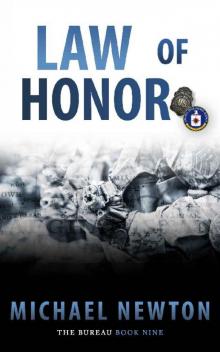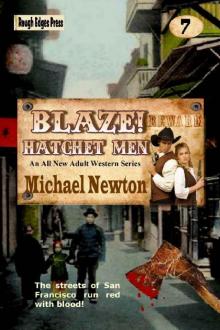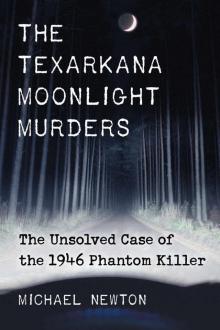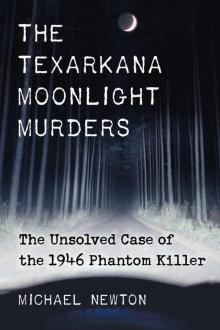- Home
- Michael Newton
The Texarkana Moonlight Murders: The Unsolved Case of the 1946 Phantom Killer Page 16
The Texarkana Moonlight Murders: The Unsolved Case of the 1946 Phantom Killer Read online
Page 16
Local authorities maintained their vigil well after the rangers had moved on. As Tillman Johnson later told reporter Carlton Stowers, “One of the things we kept doing long after the killings ended was to patrol the country roads where youngsters continued to go parking, despite all the warnings we’d been giving. One night, around midnight, I was driving down this dirt road and came up on a couple. I walked up to their car and tapped on the window and said, ‘Don’t you kids know that you could get yourselves killed being out here this time of night?’ This young girl just smiled at me and replied, ‘Don’t you know you could have gotten yourself killed?’ And with that she raised this big ol’ pistol to the car window.”3
Johnson’s vigilance seems curious, considering his personal conviction that Youell Swinney was the Phantom, safely jailed in lieu of bond, awaiting the trial that would send him to prison for life. Were his patrols intended as a balm for the taut nerves of frightened Texarkana residents? Or was his confidence in Swinney’s guilt less iron-clad than it would appear, in later interviews? At this remove, we only know that county and municipal authorities remained alert for months after the Starks attack and Earl McSpadden’s murder, waiting for the reappearance of a Phantom who would never show his hooded face again.
* * *
On the night of October 8, 1946, an unknown gunman shot and killed another couple, Lawrence Hogan and Elaine Eldridge, while they were parked on a quiet lane in Dania Beach, Florida. Broward County Sheriff Walter Clark led the investigation, aided by police and sheriffs in surrounding jurisdictions. Multiple suspects were detained, including a former member of the Detroit Police Department, but all were soon released, with the exception of two Miami men who confessed to unrelated grand larceny charges. Sheriff Clark reported discovery of a possible murder weapon, but his hopes were dashed by test-firing and comparison of its bullets to the death slugs. No motive was established for the murders by October 11, when a Fort Lauderdale newspaper reported feelers from “Sheriff J. H. Presley” in Texas.4
That same day, Director Homer Garrison sent a letter from DPS headquarters to Sheriff Clark in Florida. Describing the Texarkana Phantom’s presumed murder weapon and noting the recovery of three unidentified latent fingerprints from the Martin-Booker crime scene, Garrison closed by saying: “It would be greatly appreciated by this office if you would advise us whether or not there is any similarity in circumstances in the Fort Lauderdale case and Texarkana cases, and whether or not any latents were obtained which might be compared with the latents in our case; and whether or not a similar type of firearm was used in the killings of Miss Eldridge and Hogan as was the case in Texarkana.”5
Twelve days later, Garrison received Clark’s answer, sending it on to Captain Gonzaullas in Dallas. While Clark’s letter no longer exists in ranger files, Garrison’s missive to Gonzaullas summarized its contents, reading:
We are now informed by Sheriff Clark that these two young people were killed by a gun which is believed to be a 32 Cal. Savage Automatic Pistol or some foreign make of gun, patterned after the Savage automatic. The lethal bullet was fired from a gun having six lands and grooves and right hand twist. The projectile weighed 70.65 grains. A fired cartridge case was found which proved to be Remington ammunition.
Sheriff Clark further advises that evidence point [sic] to an attempted assault or robbery motive or possibly to a crank. It is also possible that the assassin was put to flight before completing his intent.
Since Sheriff Clark omits the mentioning of latent fingerprints, we are forced to conclude that there were no latent fingerprints obtained at the scene. Also, it is pointed out that the guns used in the Lauderdale case and the Texarkana case are, of course, quite different.6
The Savage Arms Company of Utica, New York, manufactured three different semi-automatic pistols in .32 caliber between 1907 and 1926. The first and most popular, its Savage Model 1907, featured a ten-round double-stack magazine and was offered for sale with the promotional slogan “Ten shots quick!” The French government purchased more than 40,000 of the pistols for military use during World War I, while Portugal bought 1,150. No figures are availablel for its domestic sales in the United States. Variant forms included the Model 1915 and Model 1917, manufactured in .32-caliber from 1915–16, and from 1920–26, respectively (at which times both were upgraded to .380-caliber).7
Foreign rivals of the Savage Model 1907 include Spain’s Astra 300 and Astra 400, manfactured in .32 ACP and various other calibers from 1920 to 1950, with 106,175 produced8; the Beretta M1935, carried by Italian and German troops during World War II, with manufacture ongoing from 1935 to 1967, with 525,000 produced9; the Czechoslovakian CZ vz. 27, with 452,500 manufactured under German occupation after 193810; the French MAB Model D, introduced in 1933, with over 200,000 manufactured before production ceased fifty years later11; and Germany’s Sauer 38H, manufactured from 1939 to 1945, with some 200,000 in military and police service.12 Any one of those pistols might, theoretically, have traveled home with a returning U.S. serviceman. Since neither the Phantom’s .32 nor the one used at Dania Beach were ever found, we cannot say.
Captain Gonzaullas got another tip eight days after his hopes were dashed in Florida. This time, it came from A. F. Keirsey, a reporter for the Amarillo Globe-News. On Halloween, he wrote to the Lone Wolf:
Dear Captain:
You will remember me as the elongated reporter you met in Texarkana last May, with a letter of introduction from [Texas Ranger] Dudley White.
I am writing to ask if a certain clue or lead in the Texarkana case has been checked, and if it has not I would like to go over there, of course at my own expense, and see what I can find out.
My informant, a woman bar-room habituee, says that a Mrs. Gilbert, who lives in Texarkana, seems to think she has reason to believe a certain man, whose name I am not able to find out, was the guilty person. The man in question, who operated some sort of second-hand outfit, is reputed to be a pervert. The Mrs. Gilbert’s business would put her in position to know, and she talked to my informant here. That is, the woman here recently visited Texarkana.
Please let me know by return airmail, or by collect phone call or wire, if you choose, whether or not your men have checked such a lead. If not, and if you believe it worth while, I am willing to go over there incognito and see what I can find out. Rest assured I know how to proceed, and you also have my promise that I will stay away from newspaper offices and the better hotels, so that no one will know who I am or what I am doing. Of course, I would contact you immediately in event things looked good. Otherwise, I would just write you and come home.
Thanks for your attention and an early reply.13
Once again, the Texas Ranger files contain no follow-up report or correspondence.
On November 15, 1946, Gonzaullas sent DPS headquarters a fingerprint card for potential Phantom suspect Ernest Browning, a white male with no further information provided. Director Garrison wrote back on November 16, reporting that the suspect’s prints matched no latents recovered from Phantom crime scenes, and that he had no record of arrests in Texas.14
Just over two weeks later, on December 1, one B. C. Gunter wrote to Captain Gonzaullas from Fairfield, Texas, suggesting another possible suspect. It read:
Dear Sir:
I am writing about a negro here in this county, Freestone County, that was sentenced to 30 years in prison for rape of a 70 year old negro woman. The negro is 20 or 21 years old.
About the time the murder and rape slayings were being done over at Texarkana, this negro came by my home, drove up to the house, got out of his car, came in at the yard gate up on my front porch and started on in the house without giving any signal at all of what he was seeking. I met him at the front door and stopped him.
I do not know that this would be of any benefit to you or not, it just a hunch that this negro should be questioned in regard to the Texarkana Slayings. Well, you may ask why I have not called this to the attention of the local police, well,
because the Sheriff of this County once waylaid me out on a country road between Fairfield, and where I lived out in the country to kill and murder me, so you can see why I have not reported this to him, because he would just laugh about it, and that would be all there would be to it.
This information may not be worth the paper this is written on, but if you are through Fairfield, Texas, sometime, you might just as well investigate it.15
Another curious lead lost in time, with the evaporation of official files—and thus, another dead-end.
* * *
On the morning of January 15, 1947, Betty Bersinger took her three-year-old daughter grocery shopping in the Leimert Park district of Los Angeles. They never reached the store, however, interrupted by discovery of what Bersinger took to be a broken mannequin lying near the sidewalk in a vacant lot on South Norton Avenue. A closer look revealed a woman’s naked corpse, bisected at the waist, breasts mutilated, with her mouth slashed ear-to-ear. Police identified the victim as Elizabeth Short, a would-be actress from Massachusetts, nicknamed the “Black Dahlia” by journalists after her fondness for dressing in black. Despite widespread investigation, fifty-odd false confessions, and six books naming various suspects (one penned by this author), the crime remains officially unsolved today.16
While Short’s murder bore no resemblance to the Phantom’s crimes in Texarkana, Texas Rangers were grasping at straws by early 1947. On February 10, the Dallas Times Herald ran an article about the latest Dahlia suspect, Corporal Joseph Dumais, assigned to Fort Dix in New Jersey. According to that article, Dumais had made a “long, rambling statement” to Captain William Florence of the U.S. Army’s Criminal Investigation Command, which left Florence “convinced” that Dumais had killed Short in L.A. That claim was soon disproved by soldiers who had seen Dumais around Fort Dix between January 10 and 16, but while the newspaper story called his confession a “mix-up,” rangers were still intrigued.17
On the same day that the article appeared, Lone Wolf Gonzaullas wrote to Captain Florence in New Jersey, requesting further information on Corporal Dumais. A reply came back on February 18, stating that Dumais had been stationed overseas throughout 1946, and therefore could not be the Phantom. The response did name another suspect, though: Private First Class James W. Carter, also stationed at Fort Dix, “who has been to Texarkana, Texas, exact date unknown at this time.” The army furnished Carter’s photograph and fingerprints, which were passed to Chief Glen McLaughlin, DPS Bureau of Identification and Records, on February 24, 1947. Headquarters requested comparison of Carter’s fingerprints to the Texarkana latents, with a report in quadruplicate, but the results, rendered on February 28, were negative.18
* * *
One week after Beth Short’s body was found in L.A., on January 22, 1947, Miller County Sheriff W. E. Davis wrote to FBI headquarters, seeking assistance with another suspected homicide from 1946. Davis headed his letter “Re: Unknown subject, Virgil Starks, victim; murder May 3, 1946, Texarkana, Arkansas,” but any relevant connection to that case was excised by bureau censors before they released the document to public scrutiny in 2006.19 The sheriff’s letter read:
There is transmitted with a copy of this letter the organs, properly labeled, of Marie Jones Allen [one line deleted] in connection with the above captioned matter.
Mrs. Allen died on February 3, 1946, at the Michael-Meagher Hospital of Texarkana, Arkansas, under very suspicious circumstances, her symptoms indicating that she may have been poisoned. Mrs. Allen was brought to the hospital late in the afternoon of the day preceding her death. She appeared to be suffering internally and died in great pain the next day. It was necessary that she be held on the bed, and she chewed her tongue considerably.
Her body was exhumed at the Hillcrest Cemetery of Texarkana, Texas, on January 22, 1947, in the presence of Sheriff W. E. Davis of Miller County, Arkansas, W. H. Presley, Sheriff of Bowie County, Texas, Henry Woods, Deputy Prosecuting Attorney for Miller County, Arkansas, and [name deleted], Special Agent of the F.B.I. The organs were removed from the body by [name deleted] of Bowie County, Texas, with the assistance of [name deleted] of the East Funeral Home who interred the body. Two types of fluid are employed by East, and as it is not known definitely which type was used, a bottle of each type is submitted with the organs mentioned above.
[1½ lines deleted]. It is requested that her kidneys be examined to ascertain if this disease was the cause of her death, or if there is any other unusual condition to be found in her kidneys. It is noted that the attending physician stated that she did not die of Bright’s disease.
It is further requested that the reply based on this examination be made in the manner requested by Special Agent in Charge Dean Morley of the Little Rock Field Division in his telephonic conversation with the Bureau on January 22, 1947.
P.S. There are also enclosed samples of the known medicines taken by the decedent prior to her death.20
Clyde Tolson, associate director of the FBI since 1930 and J. Edgar Hoover’s closest friend (some say closet lover), received a memo on the Allen case—again bearing the name of Virgil Starks—on January 23. It read:
SAC Morley telephoned at 10:15 A.M. today concerning the above case in which the Bureau previously has rendered assistance to the local law enforcement authorities and has also conducted laboratory examinations.
He advised that the body of Mrs. Marie Jones Allen, who died about a year ago, has been exhumed and certain organs have been forwarded to the Laboratory for toxicological examination to ascertain whether she died from poisoning. The evidence is due to arrive by train at 7:20 A.M. Friday, and will be given prompt attention upon receipt.
The local officers have developed a new theory concerning [deletion] this case. The latest suspect is [four lines deleted]. However, there was no formal written medical report and the attending physician does not confirm the allegation of Bright’s disease. There was no autopsy. The theory of the law enforcement officers is that [two lines deleted]. No special poison is suspected of having been used.
Morley requested that in the event the Bureau finds it necessary to send an expedite [sic] communication to the Sheriff’s Office in Texarkana, Arkansas, we not use wire services (either telephone or telegraph) since there was a leak at an earlier stage of the investigation and they feel it is in the Western Union office. Morley requested that any such information be forwarded to the Little Rock Field Offfice which will in turn relay it to the Sheriff’s Office. Reports forwarded by mail can, of course, be addressed directly to the Sheriff at Texarkana.21
An FBI lab report, addressed to Sheriff Davis on February 4, included the name of a suspect in the Starks and Allen cases, but the name has been excised. The bulk of the report describes examination of Marie Allen’s right kidney, stomach, liver, and a portion of her small intestine, plus various pills submitted for study with samples of commercial embalming fluids. No poison was found, but the report noted advanced decomposition of the organs and the fact that “[o]nly a relatively small number of poisons can be detected in body organs after approximately a year’s time because of the breakdown of the poisons caused by decomposition.”22 Something unusual was found, however. Specifically:
While making an examination of specimen Q31 [Allen’s stomach], a brooch was found to be imbedded in the stomach wall. This brooch was a cream color and approximately 2" in diameter. A rather large hole was present in the duodenum through which the brooch might have passed, however, the histological examination made of the ruptured region failed to indicate any inflammatory reaction. It is, therefore, believed likely that the brooch may have fallen onto the stomach at the time the post mortem examination was made.23
Handwritten notes from the lab’s work sheet indicate that the post-mortem exam was performed at the Army Medical Museum in Washington, D.C.24 It seems unlikely that a qualified pathologist would overlook a two-inch piece of jewelry while examining an excised stomach and piece of small intestine, but no other theory was advanced. The
brooch and various drugs submitted with Allen’s organs were returned to Sheriff Davis in Texarkana.25 What became of them is anyone’s guess, but without some evidence of homicide, no charges could be filed against the suspect who remains anonymous today.
What linked the Allen case to Virgil Starks? It retrospect, we can only surmise some connection to the “romantic triangle” theory discussed in Chapter 6, as a possible motive for Starks’s murder. If true, and bearing in mind the improbability of a lover’s lane rape-slayer switching to poison, that would divorce the Starks case from the Phantom’s other crimes. However, thanks in large part to the bureau’s censorship, that claim cannot be thoroughly pursued today.
* * *
Aside from dealing with the Allen case, the FBI continued fielding other pleas for help from Texarkana during February 1947. Between February 6 and 15, the Dallas field office asked bureau headquarters to examine fingerprints of three different suspects, comparing them to unidentified latent prints from the Phantom crime scenes. None matched.26
A more intriguing lead appears in a memo sent by Alex Rosen to Assistant Director Edward Tamm on February 20. It read:
PURPOSE
To request authority for Special Agent [name deleted] of the Little Rock Division to proceed to Huntsville, Texas, in the Houston territory to assist local officers in questioning [name deleted], a definite suspect in this case.
FACTS
SAC Morley advised that Special Agent [name deleted] has been stationed in Texarkana, Arkansas, and has been working in cooperation with Sheriff Bill Presley of Texarkana, Texas in interviewing [six lines deleted]. The Laboratory has identified the fact that the murderers of the first and second murders were the same.
SAC Morley advised that [2½ lines deleted]. Sheriff Presley has requested that Special Agent [name deleted] assist him in [½ line deleted]. SA [name deleted] is the only Agent familiar with the facts in this case and SAC Morley urgently recommended that authority be granted as soon as possible as it is anticipated that the Judge will order that [½ line deleted].

 Blaze! Night Riders
Blaze! Night Riders How to Write Action Adventure Novels
How to Write Action Adventure Novels Blaze! Bad Medicine
Blaze! Bad Medicine Law of Honor
Law of Honor Blaze! Hatchet Men
Blaze! Hatchet Men The Texarkana Moonlight Murders
The Texarkana Moonlight Murders The Texarkana Moonlight Murders: The Unsolved Case of the 1946 Phantom Killer
The Texarkana Moonlight Murders: The Unsolved Case of the 1946 Phantom Killer